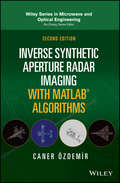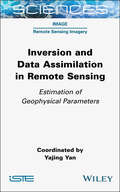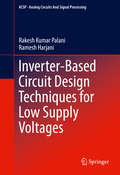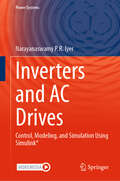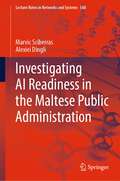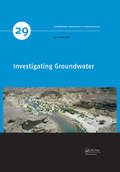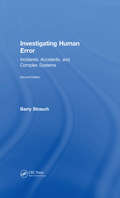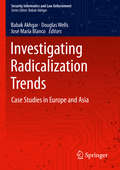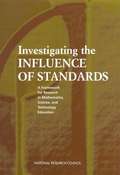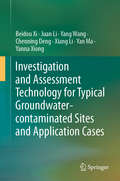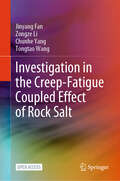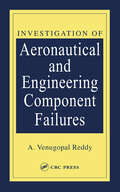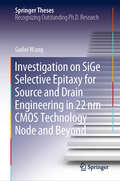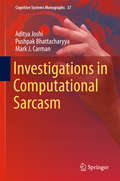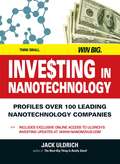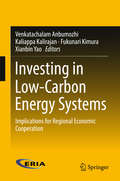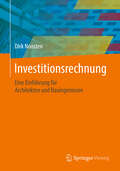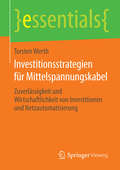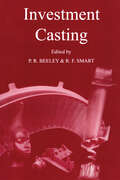- Table View
- List View
Inverse Synthetic Aperture Radar Imaging With MATLAB Algorithms
by Caner OzdemirThis book provides a full representation of Inverse Synthetic Aperture Radar (ISAR) imagery, which is a popular and important radar signal processing tool. The book covers all possible aspects of ISAR imaging. The book offers a fair amount of signal processing techniques and radar basics before introducing the inverse problem of ISAR and the forward problem of Synthetic Aperture Radar (SAR). Important concepts of SAR such as resolution, pulse compression and image formation are given together with associated MATLAB codes.After providing the fundamentals for ISAR imaging, the book gives the detailed imaging procedures for ISAR imaging with associated MATLAB functions and codes. To enhance the image quality in ISAR imaging, several imaging tricks and fine-tuning procedures such as zero-padding and windowing are also presented. Finally, various real applications of ISAR imagery, like imaging the antenna-platform scattering, are given in a separate chapter. For all these algorithms, MATLAB codes and figures are included. The final chapter considers advanced concepts and trends in ISAR imaging.
Inverse Synthetic Aperture Radar Imaging With MATLAB Algorithms (Wiley Series in Microwave and Optical Engineering)
by Caner OzdemirBuild your knowledge of SAR/ISAR imaging with this comprehensive and insightful resource The newly revised Second Edition of Inverse Synthetic Aperture Radar Imaging with MATLAB Algorithms covers in greater detail the fundamental and advanced topics necessary for a complete understanding of inverse synthetic aperture radar (ISAR) imaging and its concepts. Distinguished author and academician, Caner Özdemir, describes the practical aspects of ISAR imaging and presents illustrative examples of the radar signal processing algorithms used for ISAR imaging. The topics in each chapter are supplemented with MATLAB codes to assist readers in better understanding each of the principles discussed within the book. This new edition incudes discussions of the most up-to-date topics to arise in the field of ISAR imaging and ISAR hardware design. The book provides a comprehensive analysis of advanced techniques like Fourier-based radar imaging algorithms, and motion compensation techniques along with radar fundamentals for readers new to the subject. The author covers a wide variety of topics, including: Radar fundamentals, including concepts like radar cross section, maximum detectable range, frequency modulated continuous wave, and doppler frequency and pulsed radar The theoretical and practical aspects of signal processing algorithms used in ISAR imaging The numeric implementation of all necessary algorithms in MATLAB ISAR hardware, emerging topics on SAR/ISAR focusing algorithms such as bistatic ISAR imaging, polarimetric ISAR imaging, and near-field ISAR imaging, Applications of SAR/ISAR imaging techniques to other radar imaging problems such as thru-the-wall radar imaging and ground-penetrating radar imaging Perfect for graduate students in the fields of electrical and electronics engineering, electromagnetism, imaging radar, and physics, Inverse Synthetic Aperture Radar Imaging With MATLAB Algorithms also belongs on the bookshelves of practicing researchers in the related areas looking for a useful resource to assist them in their day-to-day professional work.
Inversion and Data Assimilation in Remote Sensing: Estimation of Geophysical Parameters (ISTE Consignment)
by Yajing YanRemote sensing data are now the primary sources for observing Earth and the Universe. Data inversion and assimilation techniques are the main tools for estimating and predicting the geophysical parameters that characterize the evolution of our planet and the Universe, using remote sensing data. Inversion and Data Assimilation in Remote Sensing explores recent advances in the inversion and assimilation of remote sensing data. It presents traditional and current neural network methods, as well as a number of topics where these methods have been developed or adapted to suit the specific nature of the field. The assimilation section covers prediction problems in volcanology and glaciology. Lastly, the inversion section covers biomass inversion using SAR images, bio-physio-hydrological inversion in coastal areas using multi- and hyperspectral images, and astrophysical inversion using telescope data.
Inverter-Based Circuit Design Techniques for Low Supply Voltages
by Ramesh Harjani Rakesh Kumar PalaniThis book describes intuitive analog design approaches using digital inverters, providing filter architectures and circuit techniques enabling high performance analog circuit design. The authors provide process, supply voltage and temperature (PVT) variation-tolerant design techniques for inverter based circuits. They also discuss various analog design techniques for lower technology nodes and lower power supply, which can be used for designing high performance systems-on-chip.
Inverters and AC Drives: Control, Modeling, and Simulation Using Simulink (Power Systems)
by Narayanaswamy P.R. IyerSuccessful development of power electronic converters and converter-fed electric drives involves system modeling, analyzing the output voltage, current, electromagnetic torque, and machine speed, and making necessary design changes before hardware implementation. Inverters and AC Drives: Control, Modeling, and Simulation Using Simulink offers readers Simulink models for single, multi-triangle carrier, selective harmonic elimination, and space vector PWM techniques for three-phase two-level, multi-level (including modular multi-level), Z-source, Quasi Z-source, switched inductor, switched capacitor and diode assisted extended boost inverters, six-step inverter-fed permanent magnet synchronous motor (PMSM), brushless DC motor (BLDCM) and induction motor (IM) drives, vector-controlled PMSM, IM drives, direct torque-controlled inverter-fed IM drives, and fuzzy logic controlled converter-fed AC drives with several examples and case studies. Appendices in the book include source codes for all relevant models, model projects, and answers to selected model projects from all chapters. This textbook will be a valuable resource for upper-level undergraduate and graduate students in electrical and electronics engineering, power electronics, and AC drives. It is also a hands-on reference for practicing engineers and researchers in these areas.
Investigating AI Readiness in the Maltese Public Administration (Lecture Notes in Networks and Systems #568)
by Alexiei Dingli Marvic SciberrasThe book presents a unique study on the Artificial Intelligence (AI) readiness of public administrations focusing on the Maltese public administration as a case study. This was conducted following the launch of the Malta AI National Strategy in 2019. Since the Maltese public administration is the driving force behind the integration of AI solutions nationwide, the research is deemed necessary to understand whether the public workforce itself is ready to face the oncoming AI revolution. The researchers applied a mixed-methods approach to gain insight and a broader perspective of the status quo concerning AI adoption. Important considerations that stem from this study include the need for increased AI knowledge among public administrators since the majority of respondents reported a lack of awareness of AI technologies and their deployment. Understanding AI-related advantages must be accompanied by a robust instructional effort at all levels of education. It was unanimously agreed that the early inclusion of AI-related courses in the Maltese educational system will aid in developing a future AI-savvy workforce. Furthermore, upskilling and reskilling the public officers will facilitate knowledgeable human capital and proficiencies required to effectively integrate AI solutions within society. The study concludes by recommending several critical reforms within governments that will improve the AI-readiness factor of any Public Administration.
Investigating Groundwater (IAH - International Contributions to Hydrogeology #29)
by Ian AcworthInvestigating Groundwater provides an integrated approach to the challenges associated with locating groundwater. Uniquely, the book provides a review of the wide range of techniques that can be deployed to investigate this important resource. Many of the practical examples given are based upon Australian experience but the methods have worldwide applicability. The book is published in colour and includes many original diagrams and photographs. Particular effort has been made to provide consistent terminology and SI units are used throughout the text. <P><P>Investigating Groundwater starts with an introduction to the historical significance of groundwater and gives an account of climate change. A description of the occurrence of groundwater in different rock types is then provided. A detailed account of surface water techniques is then followed by an account of the interconnections between surface water and groundwater. Four chapters describing groundwater hydraulics are then followed by four chapters describing the latest geophysical techniques. Once the best location of a borehole is determined using these techniques; chapters then describe appropriate drilling methods to use; provide a wide ranging review of geophysical logging, hydrochemical and isotopic techniques, before concluding with a detailed description of groundwater flow to a well. <P><P>Written for a worldwide audience of degree level geology/engineering practitioners, academics and students involved in groundwater resource investigation methods; Investigating Groundwater is essential reading for those involved in groundwater research. <P><P>Key Features: <li>Presents the theoretical background and a detailed description of the techniques used in the investigation of groundwater. <li>Describes the general occurrence of groundwater in different rock types; surface water hydrology and interconnected surface and groundwater systems. <li>Provides detailed descriptions of geophysical techniques (seismic, electrical, gravity and heat) and an account of available geophysical logging methods. <li>Reviews hydrochemical and isotope methods, followed by an account of drilling techniques. <li>Gives a detailed account of radial flow to a well, including appropriate modelling and pump-testing techniques and a consideration of non-linear flow. <P><P>Of interest to anyone involved in the development of groundwater resources, either for domestic supply, for agriculture or for mining.
Investigating Human Error: Incidents, Accidents, and Complex Systems, Second Edition
by Barry StrauchIn this book the author applies contemporary error theory to the needs of investigators and of anyone attempting to understand why someone made a critical error, how that error led to an incident or accident, and how to prevent such errors in the future. Students and investigators of human error will gain an appreciation of the literature on error, with numerous references to both scientific research and investigative reports in a wide variety of applications, from airplane accidents, to bus accidents, to bonfire disasters. Based on the author's extensive experience as an accident investigator and instructor of both aircraft accident investigation techniques and human factors psychology, it reviews recent human factors literature, summarizes major transportation accidents, and shows how to investigate the types of errors that typically occur in high risk industries. It presents a model of human error causation influenced largely by James Reason and Neville Moray, and relates it to error investigations with step-by-step guidelines for data collection and analysis that investigators can readily apply as needed. This second edition of Investigating Human Error has been brought up to date throughout, with pertinent recent accidents and safety literature integrated. It features new material on fatigue, distraction (eg mobile phone and texting) and medication use. It also now explores the topics of corporate culture, safety culture and safety management systems. Additionally the second edition considers the effects of the reduction in the number of major accidents on investigation quality, the consequences of social changes on transportation safety (such as drinking and driving, cell phone use, etc), the contemporary role of accident investigation, and the effects of the prosecution of those involved in accidents.
Investigating Radicalization Trends: Case Studies in Europe and Asia (Security Informatics and Law Enforcement)
by Babak Akhgar José María Blanco Douglas WellsThis book provides a detailed insight into the complex dynamics of radicalization that are in play amongst contemporary society. The authors focus on understanding emerging trends and models that can be used to analyse and understand modern violent extremist and xenophobic discourse. The chapters cover multiple regions, providing a collective analysis of country-specific case studies for the formulation of best practices, recommendations and learning material. It is recommended that this book may serve as a compendium for practitioners, academics, teachers and students wishing to gain state-of-the art knowledge. Topics covered by the authors vary from hands-on practical information to tactical, operational, strategic and ethical guidance. This book provides a holistic, harmonized approach based upon European internal security strategies recognizing that internal security cannot be achieved in isolation from the rest of the world. Additionally, this material resonates with the EU’s commitment to fight extremism in a rational manner, alongside promoting human rights, democracy, peace and stability within the EU Member States.Presents a comprehensive understanding of the interconnectivities and trends behind emerging radicalisation patterns;Features newest conceptual and practical knowledge to monitor, analyse and respond to radicalization around the world;Provides a comprehensive view into the methodologies for analysis, through visualizations, case studies and applications.
Investigating the Influence of Standards: A Framework for Research in Mathematics, Science, and Technology Education
by National Research CouncilSince 1989, with the publication of Curriculum and Evaluation Standards for Mathematics by the National Council of Teachers of Mathematics, standards have been at the forefront of the education reform movement in the United States. The mathematics standards, which were revised in 2000, have been joined by standards in many subjects, including the National Research Council's National Science Education Standards published in 1996 and the Standards for Technical Literacy issued by the International Technology Education Association in 2000. There is no doubt that standards have begun to influence the education system. The question remains, however, what the nature of that influence is and, most importantly, whether standards truly improve student learning. To answer those questions, one must begin to examine the ways in which components of the system have been influenced by the standards.Investigating the Influence of Standards provides a framework to guide the design, conduct, and interpretation of research regarding the influences of nationally promulgated standards in mathematics, science, and technology education on student learning. Researchers and consumers of research such as teachers, teacher educators, and administrators will find the framework useful as they work toward developing an understanding of the influence of standards.
Investigating the Nucleation, Growth, and Energy Levels of Organic Semiconductors for High Performance Plastic Electronics
by Ajay VirkarThis thesis details the significant progress made in improving the performance of organic transistors and the network conductivity of carbon nanotubes. The first section investigates organic semiconductor nucleation and growth on the most common dielectric surface used to fabricate organic thin film transistors. The nucleation and growth of the semiconductor was determined to be a critical factor affecting the device performance. Excellent dielectric modification layers, which promote desirable semiconductor growth leading to high conductivity were identified, and a technologically relevant deposition technique was developed to fabricate high quality dielectric modification layers over large areas. This may represent an important step towards the realization of large area organic circuity. In the final section, lessons learned from studying organic semiconductor nucleation and growth were utilized to improve the conductivity of carbon nanotube networks. Selective nucleation of materials at the junctions between nanotubes in the network significantly decreased the network's sheet resistance. The resulting networks may be promising candidates for transparent electrodes with a variety of optoelectronic applications.
Investigation and Assessment Technology for Typical Groundwater-contaminated Sites and Application Cases
by Juan Li Yang Wang Xiang Li Beidou Xi Yan Ma Chenning Deng Yanna XiongThis book introduces readers to environmental background investigation, pollution source intensity evaluation and risk assessment approaches used at three main types of groundwater-contaminated sites: municipal domestic waste landfills, hazardous waste landfills and oil-contaminated sites. In addition, typical contaminated sites throughout China are examined to demonstrate how these approaches can be applied for their investigation, assessment and restoration. By reading this book, readers will gain a deeper understanding of the restoration and management of typical groundwater-contaminated sites.
Investigation in the Creep-Fatigue Coupled Effect of Rock Salt
by Chunhe Yang Tongtao Wang Jinyang Fan Zongze LiThis open access book provides the uniaxial, triaxial, fatigue, creep, creep-fatigue loading tests in order to investigate the salt mechanical response and the related damage mechanisms defining relation between plastic deformation, dilatancy and damage. Based on the experimental results, a new creep-fatigue constitutive model for salt rock that considers creep-fatigue interaction was established by incorporating a state variable that characterizes rock hardening level on the basis of the Norton creep model. Different salt rock mechanical test data sets with varying stress paths were used to validate this creep-fatigue constitutive model. The fit curves and test curves of the stress paths demonstrate good consistency, indicating that the model comprehensively considers the effects of time, load, and state on salt rock's creep-fatigue, effectively describing the creep-fatigue plastic deformation features of salt rock under different stress paths.
Investigation of Aeronautical and Engineering Component Failures
by A. Venugopal ReddyFailure analysis has grown enormously in it scope and utility in recent years. Developments in materials characterization techniques have made the job of a failure analyst easier and more precise, but it still requires not only a strong background in materials science and engineering, but also practical experience--or at least a strong understandin
Investigation on SiGe Selective Epitaxy for Source and Drain Engineering in 22 nm CMOS Technology Node and Beyond (Springer Theses)
by Guilei WangThis thesis presents the SiGe source and drain (S/D) technology in the context of advanced CMOS, and addresses both device processing and epitaxy modelling. As the CMOS technology roadmap calls for continuously downscaling traditional transistor structures, controlling the parasitic effects of transistors, e.g. short channel effect, parasitic resistances and capacitances is becoming increasingly difficult. The emergence of these problems sparked a technological revolution, where a transition from planar to three-dimensional (3D) transistor design occurred in the 22nm technology node. The selective epitaxial growth (SEG) method has been used to deposit SiGe as stressor material in S/D regions to induce uniaxial strain in the channel region. The thesis investigates issues of process integration in IC production and concentrates on the key parameters of high-quality SiGe selective epitaxial growth, with a special focus on its pattern dependency behavior and on key integration issues in both 2D and 3D transistor structures, the goal being to improve future applications of SiGe SEG in advanced CMOS.
Investigations in Computational Sarcasm (Cognitive Systems Monographs #37)
by Aditya Joshi Pushpak Bhattacharyya Mark J. CarmanThis book describes the authors’ investigations of computational sarcasm based on the notion of incongruity. In addition, it provides a holistic view of past work in computational sarcasm and the challenges and opportunities that lie ahead. Sarcastic text is a peculiar form of sentiment expression and computational sarcasm refers to computational techniques that process sarcastic text. To first understand the phenomenon of sarcasm, three studies are conducted: (a) how is sarcasm annotation impacted when done by non-native annotators? (b) How is sarcasm annotation impacted when the task is to distinguish between sarcasm and irony? And (c) can targets of sarcasm be identified by humans and computers. Following these studies, the book proposes approaches for two research problems: sarcasm detection and sarcasm generation. To detect sarcasm, incongruity is captured in two ways: ‘intra-textual incongruity’ where the authors look at incongruity within the text to be classified (i.e., target text) and ‘context incongruity’ where the authors incorporate information outside the target text. These approaches use machine-learning techniques such as classifiers, topic models, sequence labelling, and word embeddings. These approaches operate at multiple levels: (a) sentiment incongruity (based on sentiment mixtures), (b) semantic incongruity (based on word embedding distance), (c) language model incongruity (based on unexpected language model), (d) author’s historical context (based on past text by the author), and (e) conversational context (based on cues from the conversation). In the second part of the book, the authors present the first known technique for sarcasm generation, which uses a template-based approach to generate a sarcastic response to user input. This book will prove to be a valuable resource for researchers working on sentiment analysis, especially as applied to automation in social media.
Investigations into the Combustion Kinetics of Several Novel Oxygenated Fuels (Springer Theses)
by Wenyu SunIn this thesis, attention was paid to several novel oxygenated fuels—carbonates, polyethers and ketones. Combustion kinetic investigations were performed for typical representative compounds, including dimethyl carbonate, diethyl carbonate, cyclopentanone, 3-pentanone, 1,2-dimethoxyethane and dimethoxymethane. For experiments, suitable diagnostic techniques were used to measure the detailed speciation information of the target fuels under different conditions. For kinetic modeling, rate coefficients for crucial elementary reactions were obtained through high-level theoretical calculations. Based on that, validated kinetic models with good predictive performances were developed. On the basis of experimental measurements and model interpretations, this work highlighted two important combustion characteristics regarding the practical use: the pollutant formation and the ignition performance. Besides, the correlation between oxygen-containing functional groups and the aforementioned combustion characteristics was revealed. To reveal the potential interactions between the reaction networks of oxygenated additives and the hydrocarbon base fuels during combustion. Chemical structures of laminar premixed flames fueled by binary fuels were measured, and by changing the initial fuel compositions, the addition effects of the oxygenates on the fuel consumption and pollutant formation behaviors were explored. It was found that complicated chemical interactions do not exist in the reaction networks under the investigated conditions.
Investing In Nanotechnology: Think Small. Win Big
by Jack UldrichA Simon & Schuster eBook. Simon & Schuster has a great book for every reader.
Investing on Low-Carbon Energy Systems
by Venkatachalam Anbumozhi Kaliappa Kalirajan Fukunari Kimura Xianbin YaoThis book focuses on multi-level actions that have attracted considerable interest and discussion within academia, decision makers and the public as a tool to assess anthropogenic effects of low-carbon energy development. The book begins with an overview of the state of the art policies in emerging economies, which provides a starting point for understanding the concept of low-carbon green growth. A unified framework for structuring, categorizing, and integrating various regional-level actions is established on the basis of a thorough investigation into the theoretical and methodological aspects of non-conventional energy policies that have been widely adopted. Furthermore, the book brings clarity to the relationship between clean energy policies and stakeholder participation, and the significance of coordinated actions at the regional level. The findings provide novel insights and policy tools to help decision-makers in identifying ways to mobilize private investment in low-carbon energy systems.
Investition und Finanzierung im Bauunternehmen: Grundlagen und Anwendung mit Lernvideos (erfolgreich studieren)
by Stefanie Friedrichsen Steffen AhtingDieses Lehrbuch vermittelt Studierenden des Bauwesens volks- und betriebswirtschaftliche Zusammenhänge sowie die Grundlagen der Finanzierung, Investitions- und Liquiditätsplanung im Bauunternehmen.Ein durchgängiges begleitendes Fallbeispiel aus der Baubranche veranschaulicht in Form von 39 Lernvideos und Erklärvideos den Lehrstoff und erläutert typische Problemstellungen in Bauunternehmen.Das Lehrbuch ist in der Springer Vieweg Reihe "erfolgreich studieren" erschienen
Investitions- und Wirtschaftlichkeitsrechnung für Ingenieure (essentials)
by Ekbert HeringFür Investitionen bestehen häufig mehrere Alternativen. Um die richtige auszuwählen, werden die einzelnen Alternativen mit statischen Verfahren (ohne Zinsrechnung) nach ihren Kosten, ihren möglichen Gewinnen und ihrer Rentabilität untersucht. In den dynamischen Verfahren werden die Alternativen nach ihren Kapitalströmen (Kapitalzuflüsse und -abflüsse) mit einer Zinseszinsrechnung bewertet.
Investitionsrechnung: Eine Einführung für Architekten und Bauingenieure
by Dirk NoostenDieses Fachbuch führt Baupraktiker in die Thematik der Investitionsrechnung ein und berücksichtigt dabei besonders Fragestellungen aus der Bau- und Immobilienbranche. Die Investitionsrechnung spielt auch für Bauingenieure, Architekten, Wirtschaftsingenieure mit Schwerpunkt Bauwesen und für Immobilienwirte eine wichtige Rolle. Sie findet ihren Niederschlag in zahlreichen Themengebieten wie z. B. der Immobilienfinanzierung, Lebenszyklusberechnung, Wirtschaftlichkeitsrechnung, Immobilienbewertung und dynamischen Kostenvergleichsrechnung.
Investitionsstrategien für Mittelspannungskabel: Zuverlässigkeit und Wirtschaftlichkeit von Investitionen und Netzautomatisierung (essentials)
by Torsten WerthTorsten Werth zeigt auf, welche Auswirkungen der Zeitpunkt einer Erneuerungsinvestition auf die Zuverlässigkeit eines Energieverteilnetzes hat oder welche Annahmen Netzplaner hinsichtlich des Alterungsverhaltens der elektrischen Betriebsmittel treffen können. Dies sind nur zwei von vielen typischen, immer wiederkehrenden Aspekten bei der Suche nach der optimalen Erneuerungsstrategie. Unter dem größer werdenden Einfluss der Regulierung entsteht ein besonderer Bedarf an einem interdisziplinären Systemdenken. Gleichzeitig müssen Vorgehensweisen zur Strategiefindung geschaffen werden, die in der täglichen Praxis den Anspruch an einer präzisen Aussagekraft bei gleichzeitig vertretbarem Aufwand geschaffen werden.
Investment Casting
by Philip R. Beeley Robert F. SmartThis modern book on investment casting fills a substantial gap in the literature of metal founding. The investment casting sector of the foundry industry has seen rapid growth; despite this the literature devoted specially to investment casting and its products has remained relatively sparse. Investment Casting has been produced by drawing upon the knowledge of authorities within or closely associated with the industry, in co-operation with the British Investment Casting Trade Association, examining the process and its products in a way which is useful both to the industry and to design engineers. To this end the earlier chapters are devoted to each of the main production stages from tooling to finishing, with health and safety treated separately, commensurate with its current importance.
Investment Decisions and the Logic of Valuation: Linking Finance, Accounting, and Engineering
by Carlo Alberto MagniThis book presents a new approach to the valuation of capital asset investments and investment decision-making. Starting from simple premises and working logically through three basic elements (capital, income, and cash flow), it guides readers on an interdisciplinary journey through the subtleties of accounting and finance, explaining how to correctly measure a project’s economic profitability and efficiency, how to assess the impact of investment policy and financing policy on shareholder value creation, and how to design reliable, transparent, and logically consistent financial models.The book adopts an innovative pedagogical approach, based on a newly developed accounting-and-finance-engineering system, to help readers gain a deeper understanding of the accounting and financial magnitudes, learn about new analytical tools, and develop the necessary skills to practically implement them. This diverse approach to capital budgeting allows a sophisticated economic analysis in both absolute terms (values) and relative terms (rates of return), and is applicable to a wide range of economic entities, including real assets and financial assets, engineering designs and manufacturing schemes, corporate-financed and project-financed transactions, privately-owned projects and public investments, individual projects and firms. As such, this book is a valuable resource for a broad audience, including scholars and researchers, industry practitioners, executives, and managers, as well as students of corporate finance, managerial finance, engineering economics, financial management, management accounting, operations research, and financial mathematics. It features more than 180 guided examples, 50 charts and figures and over 160 explanatory tables that help readers grasp the new concepts and tools. Each chapter starts with an abstract and a list of the skills readers can expect to gain, and concludes with a list of key points summarizing the content.

